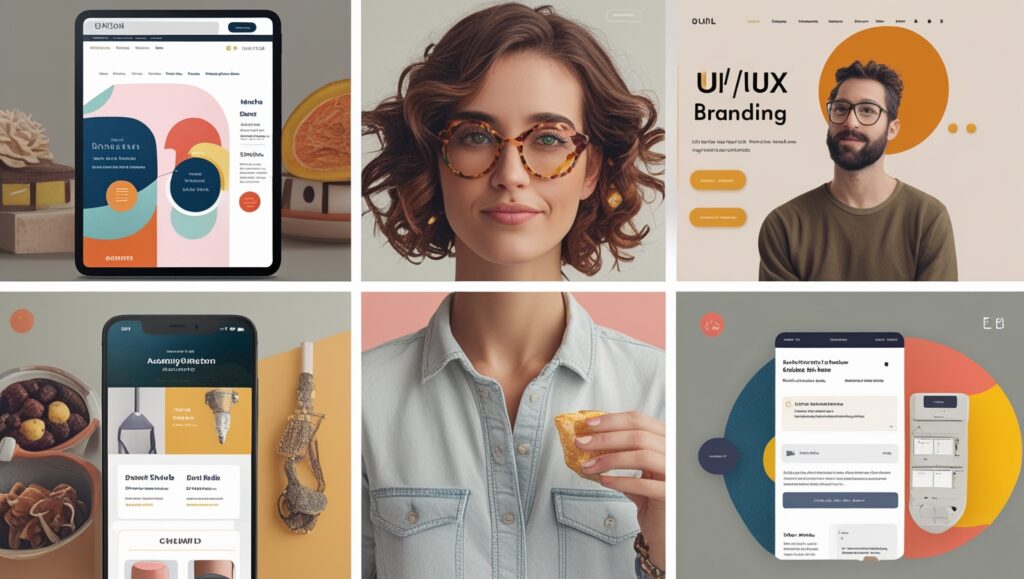click to get service View profile
Discover practical tips to fix common UI/UX mistakes designers make. Improve user experience, enhance interface design, and create seamless, intuitive designs for better user retention and satisfaction.
In today’s fast-paced digital world, users demand intuitive, beautiful, and seamless experiences — and they’re quick to abandon products that fail to deliver. Even experienced designers can fall into common UI/UX mistakes that negatively impact usability and user satisfaction.
Great design isn’t just about aesthetics — it’s about functionality. UI/UX mistakes like confusing navigation, cluttered interfaces, and inconsistent patterns can frustrate users and result in lost opportunities. The good news is, identifying and fixing these common UI/UX mistakes is simple once you know what to look for.
In this blog, we’ll dive into the most common UI/UX mistakes designers make, why they happen, and how you can fix (or avoid) them to create smoother, smarter, and more successful digital experiences. Let’s get started!
2. Why UI/UX Mistakes Happen
Even the best designers aren’t immune to making UI/UX mistakes. Recognizing why these mistakes happen is the first crucial step toward preventing them. Here are some of the most common reasons behind UI/UX mistakes and how you can stay ahead of them.
1. Designing Without User Research
Many designers jump straight into creating wireframes or high-fidelity screens without deeply understanding their users’ real needs, behaviors, and pain points.
Without user research (interviews, surveys, usability testing), designs are based on guesses rather than facts — leading to mismatched expectations and poor usability.
2. Rushing to Meet Deadlines
In fast-paced environments, the pressure to deliver quickly can lead designers to cut corners, skipping crucial UX processes like prototyping, testing, and iteration. This often results in UI/UX mistakes, producing polished-looking products that may feel confusing or incomplete to users.
3. Over-Focusing on Visual Design
While beautiful visuals are important, focusing only on how a product looks (colors, typography, animations) without considering how it works (flow, interactions, feedback) can lead to designs that are impressive but unusable.
4. Designing for Stakeholders, Not Users
Sometimes designs are tweaked or built to satisfy internal stakeholders (like marketing, management, or investors) instead of real users.
This can lead to unnecessary features, bloated interfaces, and confusing flows that don’t truly serve the user’s journey.
5. Lack of Testing and Iteration
Many teams treat design as a “one-and-done” process. But great UX comes from constant testing, feedback, and refinement.
Without usability testing (even basic), designers miss real-world insights — and small issues can snowball into big user experience problems.
6. Ignoring Accessibility
“Another common blind spot in design is overlooking accessibility for all users, including those with disabilities. Failing to follow accessibility best practices can result in significant UI/UX mistakes, frustrating users and potentially leading to legal and ethical concerns.
7. Miscommunication Between Design and Development Teams
When designers and developers aren’t aligned — missing design specs, unclear interactions, or misunderstood requirements — the final product can deviate from the intended user experience.
Key Takeaway:
UI/UX mistakes usually don’t happen because of a lack of skill — they happen because of rushed processes, missing information, or misplaced priorities.
The best defense? Slow down when it matters, stay user-centered, and build feedback loops into your design process.
3. Most Common UI/UX Mistakes and How to Fix Them

Even with the best intentions, certain UI/UX mistakes keep happening across websites, apps, and products. Let’s break down the most common ones — and, more importantly, how you can fix them:
Mistake 1: Overcomplicated User Interfaces
Problem:
Trying to do too much at once leads to cluttered screens, confusing layouts, and overwhelming choices. Users feel lost or frustrated.
Fix:
- Follow the principle of “Less is More.”
- Focus each screen/page on one primary action.
- Remove unnecessary elements and prioritize the most critical information.
- Use whitespace smartly to give users breathing room.
Mistake 2: Poor Navigation Design
Problem:
If users can’t quickly figure out where to go or how to accomplish their goal, they’ll abandon the experience.
Fix:
- Use familiar navigation patterns (bottom nav bars, hamburger menus, breadcrumbs).
- Clearly label menu items — avoid jargon.
- Keep the navigation consistent across all pages/screens.
- Always offer a clear way to “go back” or “start over.”
Mistake 3: Ignoring Mobile-First Design
Problem:
Many designs work great on desktops but break down on smaller screens, leading to frustrating mobile experiences.
Fix:
- Design with mobile-first principles: start with the smallest screen, then scale up.
- Use responsive layouts, flexible grids, and scalable typography.
- Test your design on real devices, not just desktop browser previews.
Mistake 4: Inconsistent Visuals and Interactions
Problem:
When buttons, fonts, colors, or interactions change unpredictably, users lose trust and feel disoriented.
Fix:
- Build a clear design system (typography, color palettes, components).
- Stick to consistent styles for buttons, links, and interactions across the app or site.
- Keep alignment, spacing, and sizing uniform.
Mistake 5: Lack of Feedback After User Actions
Problem:
When users click a button or submit a form and nothing obvious happens, they wonder: “Did it work?”
Fix:
- Use micro-interactions: loading spinners, animations, confirmation messages.
- Show progress indicators for long tasks (e.g., form submissions, file uploads).
- Make every user action feel acknowledged.
Mistake 6: Overloading Users With Information (Cognitive Overload)
Problem:
Bombarding users with too many choices, details, or actions at once creates confusion and decision fatigue.
Fix:
- Apply Progressive Disclosure: reveal information step-by-step as needed.
- Break complex tasks into smaller steps (wizards, onboarding flows).
- Highlight key actions and hide secondary actions when not needed.
Mistake 7: Slow Loading and Heavy Visuals
Problem:
Heavy images, videos, and fancy animations can slow down the app/site, frustrating users and killing conversions.
Fix:
- Optimize assets: use compressed images, SVGs, and lightweight fonts.
- Limit unnecessary animations or use CSS-based lightweight animations.
- Implement lazy loading for images and videos.
Mistake 8: Forgetting Accessibility Needs
Problem:
Designs that ignore accessibility exclude millions of users and even risk legal trouble.
Fix:
- Ensure good contrast ratios for text and backgrounds.
- Use proper heading hierarchy (H1, H2, H3) for screen readers.
- Make buttons large enough for easy tapping.
- Add alternative text (alt text) for images.
Key Takeaway:
Fixing these common mistakes isn’t just about making your design prettier — it’s about making it functional, fast, accessible, and user-focused.
By paying attention to these areas, you can build products that users love and trust.
4. Bonus: UX Mistakes Specific to SaaS and Mobile Apps
SaaS platforms and mobile apps present unique UX challenges that go beyond regular websites. The user journey tends to be longer, more complex, and directly tied to business goals like retention, upgrades, or subscriptions, making UI/UX mistakes even more impactful.
Here are the most common UX mistakes in these domains — and how to fix them:
Mistake 1: Complicated or Weak Onboarding Experience
Problem:
First impressions matter. A poor or confusing onboarding experience can cause users to abandon your product before they even start using it properly.
Fix:
- Keep onboarding short and simple.
- Highlight the core value immediately (“aha moment”).
- Use tooltips, progress bars, or simple guided tours.
- Allow users to skip onboarding if they prefer.
Mistake 2: Not Showing Immediate Value (“Time to First Value” Too Long)
Problem:
If users have to spend too much time setting things up before seeing any benefits, they’ll lose interest.
Fix:
- Focus on helping users achieve a quick win within the first few minutes.
- Offer templates, defaults, or pre-filled data to make setup easier.
- Guide users toward high-value actions quickly (e.g., send the first email, create the first project).
Mistake 3: Complex Pricing and Subscription Flows
Problem:
Unclear or confusing subscription flows (hidden fees, unclear plan differences) frustrate users and hurt conversions.
Fix:
- Clearly explain pricing and what each plan offers.
- Make the upgrade/downgrade process frictionless.
- Provide in-app messaging around billing and trials (before the trial ends).
Mistake 4: Poor Empty State Designs
Problem:
When users land on a screen with no data (e.g., no projects yet, no messages yet), it feels broken or confusing.
Fix:
- Design friendly empty states with helpful messages and illustrations.
- Suggest next actions (“Create your first project!”) or link to help articles.
- Turn “nothing” into an opportunity for education.
Mistake 5: Overcomplicated Feature Sets
Problem:
Trying to pack too many features into SaaS apps often overwhelms users and causes feature fatigue.
Fix:
- Focus on core user jobs (“Jobs to be Done” framework).
- Hide advanced features behind “Advanced Settings” or “Learn More” links.
- Prioritize features based on user research and feedback — not internal opinions.
Mistake 6: Forgetting Mobile Optimization for SaaS
Problem:
Many SaaS platforms neglect their mobile web or native app experiences, assuming users will only use desktop.
Fix:
- Prioritize a responsive web app design from the start.
- Optimize critical user flows (logins, dashboards, reports) for mobile.
- Use mobile-specific navigation patterns (bottom navs, thumb-friendly layouts).
Mistake 7: Ignoring User Retention Mechanics
Problem:
Getting users is hard — keeping them is harder. Many apps fail because they don’t focus on post-signup engagement.
Fix:
- Add email nudges, push notifications, or in-app prompts for re-engagement.
- Celebrate milestones and progress (“You completed 5 tasks — great job!”).
- Regularly remind users of the value they’re getting.
Key Takeaway:
In SaaS and mobile UX, speed to value, clarity, and continual engagement are critical. Small friction points early on can cost you loyal users later.
By smoothing out onboarding, showcasing value fast, and designing thoughtfully for every state (including empty ones), you can dramatically boost user satisfaction and retention.
5. How to Regularly Avoid These Mistakes

Spotting and fixing mistakes after a product is live can be expensive and time-consuming.
The smarter approach? Develop habits and systems within your design process that proactively prevent common UI/UX mistakes, ensuring smoother user experiences from the start.
Here’s how:
1. Always Start with User Research
- Before designing anything, spend time understanding your users: their problems, behaviors, motivations, and goals.
- Methods like surveys, interviews, user personas, and journey maps give you a strong foundation.
- Tip: Even 5 quick user interviews can reveal patterns you wouldn’t guess on your own.
2. Follow a Clear UX Process
- Avoid skipping critical stages like wireframing, prototyping, or usability testing just to “save time.”
- A simple UX process:
Research → Wireframe → Prototype → Test → Iterate → Deliver - Tip: Even quick, low-fidelity prototypes tested early can save massive redesign efforts later.
3. Collaborate Early and Often with Developers
- Designers and developers should work together from the start, not just at handoff.
- Discuss feasibility, technical limitations, and edge cases early.
- Tip: Use tools like Figma comments, Zeplin, or design tokens to smooth collaboration.
4. Test Designs Continuously
- Don’t treat testing as a “one-time” thing. Test early versions, mid-development versions, and final products.
- Conduct usability testing, A/B tests, or even guerrilla testing (quick feedback from random users).
- Tip: Tools like Maze, UsabilityHub, and PlaybookUX make remote testing easier.
5. Create and Stick to a Design System
- A good design system prevents inconsistency in components, typography, spacing, and colors.
- Document design guidelines and usage patterns clearly.
- Tip: Update the design system regularly as your product evolves.
6. Build Accessibility Into Your Design Thinking
- Make accessibility part of your design checklist — not an afterthought.
- Regularly check color contrasts, keyboard navigation, screen reader support, and tap targets.
- Tip: Use tools like Stark, Axe, or Lighthouse audits for quick accessibility testing.
7. Gather Real User Feedback Post-Launch
- Don’t assume your product is perfect after launch.
- Set up channels for feedback: in-app surveys, NPS scores, feedback widgets, or user interviews.
- Tip: Look at both quantitative data (analytics, heatmaps) and qualitative feedback (user comments, support tickets).
8. Learn from Mistakes and Improve Your Process
- Every mistake is an opportunity to improve.
- After a project wraps up, conduct a design retrospective: What worked? What didn’t? How can we do better next time?
Key Takeaway:
Avoiding UI/UX mistakes isn’t about being perfect — it’s about building smart processes that catch issues early, learning from user behavior, and continuously improving your designs.
Think of good UX not as a project deliverable — but as an ongoing mindset.
Conclusion
“UI/UX design is a constantly evolving field, and making mistakes is part of the learning process. The key to exceptional user experiences lies in recognizing common UI/UX mistakes and knowing how to avoid them. By prioritizing user research, iterating on designs, and maintaining consistency and clarity throughout the process, you can create interfaces that are not only visually appealing but also intuitive, efficient, and user-friendly.
Even the most experienced designers make UI/UX mistakes, but what sets the best apart is their ability to identify and fix these errors early, preventing them from impacting the user experience. Whether it’s simplifying complex interfaces, improving navigation, or prioritizing accessibility, each small adjustment can lead to a significant improvement in user satisfaction.
“By applying the tips and techniques shared in this blog, you’ll be well-equipped to avoid the most common UI/UX mistakes and design digital products that users will truly love. Keep testing, stay curious, and always prioritize the user at the heart of your design process.
Take action now! Reflect on your past projects, identify any UX pain points, and start applying these solutions today. Small improvements lead to big results, and the more you practice, the better your designs will become.
Optional Sections to Make It Even More Powerful:
To make your UI/UX designs more effective and impactful, here are some powerful additions to consider:
- Real-World Case Studies: Learn from successful brands like Airbnb and Spotify, who improved their UI/UX by simplifying processes and refining user flows, boosting engagement and retention.
- Essential UX Tools: Use tools like Figma for collaboration, Maze for usability testing, and Stark to ensure accessibility standards, helping you avoid common design mistakes.
- UX Checklist: Keep your designs on track with this simple checklist:
- Is navigation clear and intuitive?
- Are design elements consistent across screens?
- Does the interface offer feedback for actions?
- Trends to Watch: Stay ahead of the curve by incorporating dark mode, microinteractions, and personalized UX through AI to keep your designs fresh and engaging.
- Interactive Challenge: Apply these tips today by choosing one aspect of your design to improve—be it simplifying a form or enhancing feedback—and share your results using the hashtag #UXFixChallenge.
Incorporating these elements will make your designs more user-friendly, impactful, and aligned with current trends, ensuring a seamless user experience every time.

